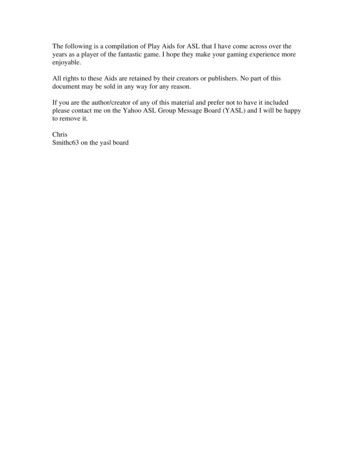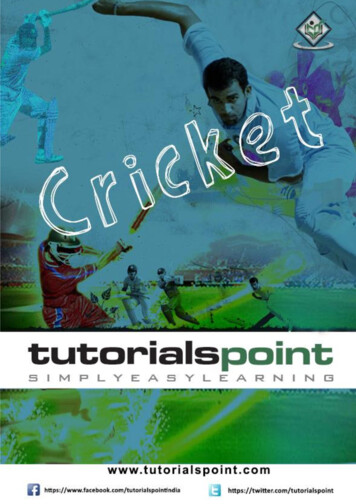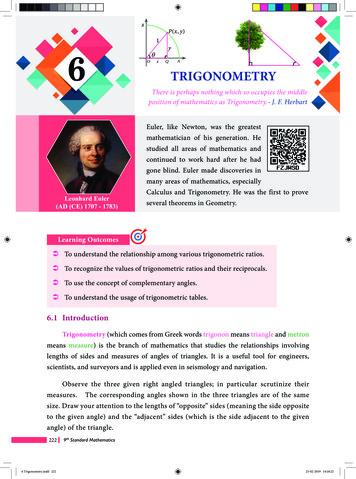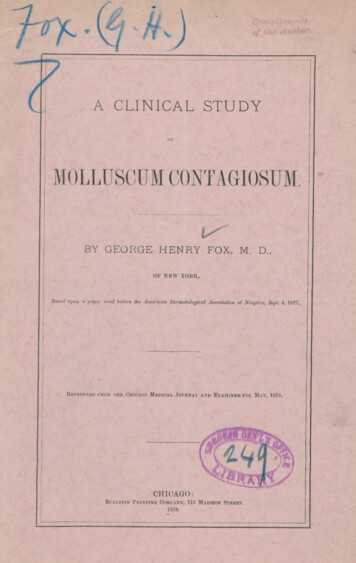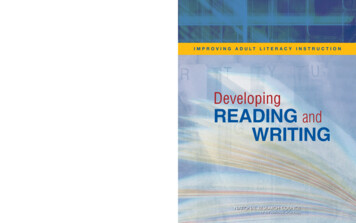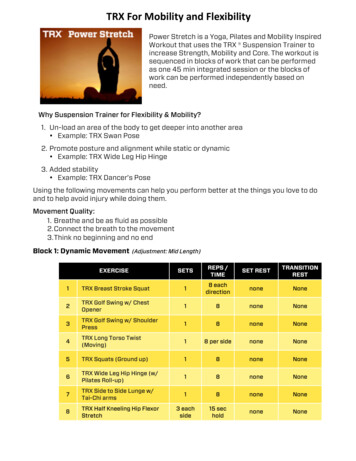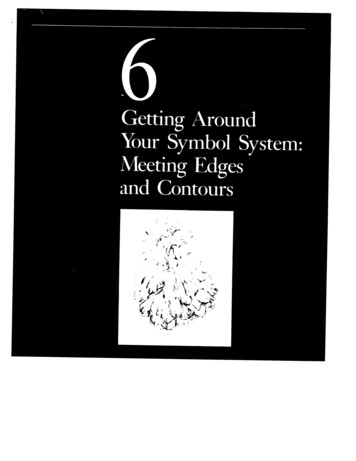
Transcription
l)rawing on the Right Side o the BrainWhave reviecd your childhood art and the development of the set of symbols that formed your childhood languageof drawing. 1’his process paralleled the development of othersymbol systems: speech, reading, writing, and arithmetic.Whereas these other symbol systems formed useful foundationsfor later development of verbal and computational skills, childhood drawing symbols seem to inteifere with later stages of art.Thus, the central problem of teaching realistic drawing toindividuals from age ten or SO onward is that the left brain seemsto insist on using its memorized, stored drawing symbols whenthey are no longer appropriate to the task. In a sense, the leftbrain unfortunately continues to “think” it can draw long afterthe ability to process spatial, relational information has beenlateralized, or shifted, to the right brain. When confronted witha drawing task, the left hemisphere comes rushing in with itsverbally linked symbols; afterward, ironically, the left brain is alltoo ready to supply derogatory words of judgment if the drawinglooks childlike or naive.In the last chapter 1 said that an effective way to “turn off”your dominant left hemisphere, with its verbal, symbolic style ofworkii, .‘ to “turn on’ your nondominant right brain, withits spatial relational style, is to present your brain with a task thatthe left brain either can’t or wont work at. We have used theVase-Faces drawings and upside-down drawings to gain accessto your R-mode. Now we’ll try another, more drastic strategythat will force a stronger cognitive shift and suppress yourL-mode more completely.The technique is called “pure contour drawing,” and your lefthemisphere is probably not going to like it. Introduced by arespected art teacher, Kimon Nicolaides, in his 1941 book, TheNatural Way to Draw, the method has been widely used by artteachers. I believe that our new knowledge about how the braindivides its work load provides a conceptual basis for understanding why pure contour drawing is effective as a teaching method.At the time of writing his book, Nicolaides apparently felt thatthe reason the pure contour method improved students’ drawingwas that it caused students to use both senses of sight and touch:Nicolaides recommended that students imagine that they weretouching the form as they drew. It seems more likely now that themethod works because the left brain rejects the slow, meticulous,
Meeting Edges and Contourscomplex perceptions of spatial, relational information, thus allowing access to R—mode processing. In short, pure contourdrawing doesn’t suit the left brain’s style; it suits the style of theright brainagain, just what we want.Before describing the method, I’ll define some terms.In drawing, a contour is defined as anfde as you perceive it. As amethod, pure contour drawing (which is sometimes termed“blind contour drawing”) entails close, intense observation asyou draw the edges of a form without looking at the drawing whileit is in progress.An edge, as the term is used in drawing, is the place where twothinç.’c meet. In drawing your hand, for example, the places wherethe air (which in drawing is thought of as background or negativespace) meets the surface of your hand, the place where a fingernailmeets the surrounding skin, the place where two folds of skinmeet to form a wrinkle, and so on, are shared edges. The sharededge (called a contour) can be describedthat is, drawnas asingle line, which is called a contour line. (We’ll he working withedges again in the next chapter on negative space.)This concept of edges is a fundamental concept in art, havingto do with unity, perhaps the most important principle in art.Unity is achieved when everything in a composition fits togetheras a coherent whole, each part contributing to the wholeness ofthe total image.———AN EXERCISE IN EDGESTo firmly set in your mind the concept of unified shapes andspaces that share edges, do the following exercise in imaging andseeing edges:I. See in your mind’s eye a disassembled child’s jigsaw puzzleof six or eight painted pieces. The pieces will go together to forma picture of a sailboat on a lake. Imagine that the jigsaw pieces areshaped like the forms: a single white piece is the sail; a red piece,the boat, etc. Imagine the rest of the pieces in your own wayland, dock, clouds, whatever.2. Now assemble the pieces in your imagination. See that thetwo edges come together to form a single line (imagine this as aprecision-cut puzzle). These shared edges form contour lines. Allof the piecesspaces (sky and water) and shapes (boat, sail,land, etc.)fit together to form the whqle puzzle.3. Next regard your own hand, one eye closed t flatten theimage (closing one eye removes binocular depth perception).———83‘Merely to see, therefore, is notenough. It is necessary to have afresh, vivid, physical contact withthe object you draw through as many(II the senses as possibleand especially through the sense of touch.”Kimon NicolaidesThe Natural 1’ay to Draw——
l)rawing on the Right Side of the BrainThink of your hand and the air around it as a jigsaw puzzle, thespaces (negative spaces) between the fingers sharing edges withthe fingers; the shape of the flesh around each fingernail sharingan edge with the fingernail; two areas of skin sharing an edge toform a wrinkle. The whole image, made up of shapes and spaces,fits together like a jigsaw puzzle.4 Now direct your eyes at one specific edge anywhere onyour hand. Imagine in your mind’s eye that you are drawing thatedge as a single, slow, exact line on a piece of paper. \s youreyes move slowly along the edge, imagine that you can simultaneously see the line being drawn, as though by some magicalrecording device.USING PURE CONTOUR DRAWINGTO BYPASS YOUR SYMBOL SYSTEMIn my classes, I demonstrate pure contour drawing, describinghow to use the method as I drawf I can manage to keeptalking (an L-mode function) while I’m trying to use my rightbrain for drawing. Usually, I start out all right but begin trailingoff in mid-sentence after five minutes or so. By that time, howstudents will have the idea.hIIo4nig the demonstration, I show examples of previousstudents pure contour drawings.—Before you begin: To best achieve an approximation of the classroom procedure, be sure to read all of the instructions andexamine all of the student drawings in the Student Showingbefore beginning your drawing.I. Find a place where you can be alone and uninterrupted forat least twenty minutes.2. Set an alarm clock or timer, if you wish, for tenty minutes just before you start your drawing. (This is to remove thenecessity of keeping track of timean L-mode function.) Or, ifyou have plenty of time and don’t care about how long you mightbe drawing, omit the timer.3. Place a piece of paper on a table and tape it down in anyposition that seems comfortable. Taping is necessary so that thepaper wont shift about while you are drawing.4. You are going to draw a picture of your own handyourleft hand if you are right-handed, your right hand if you areleft-handed. Arrange yourself so that your drawing hand, hold——84
Meeting Edges and Contoursing the pencil, is ready to draw on the taped-down paper.5. Face all the way around to the opposite direction, gazing atthe hand you will draw. Be sure to rest the hand on some support, because you will be holding the same position for quite along time. You are going to draw your hand without being able tosee what you are drawing (see the position in Figure 6-1). Facingaway from your drawing is necessary to achieve the purpose ofthe method: first, to focus your entire attention on the visual inforination out there in front; and second, to remove all attention fromthe drawing, which might trigger off your old symbolic patternsmemorized from childhood as the “way to draw hands.” Youwant to draw only what you see (in spatial R-mode) and not whatyou know (in symbolic L-mode). Turning all the way aroundisnecessary also because the impulse to look at the drawing isalmost overwhelming at first. If you draw in the normal position/I’—-Fig. 6-1. The turned-around drawing position for pure contour drawing.
I)rawing on the Right Side of the Brain“In oneself lies the whole world andit yoo know how to look and learn,then the door is there and the key isin your hand. \ohody on earth cangive you either the key or the door toopen, except yourself.—j. KrishnamurtiYou ;Ire the Worldand say to yourself, “I just wont look, you will very likely findyourself stealing peeks out of the corner of your eye. This willreactivate the L-mode and defeat the purpose of the exercise.6. In the turned-around position, focus your eyes on somepart of your hand and perceive an t’are. At the same time, placethe point of your pencil on the paper (at any place well within theoutside borders of the paper).7. Very slowly, creeping a millimeter at a time, move youreyes along-the edge of your hand, observing every minute variationand undulation f the edge. As your eyes move, also move yourpencil point at the same slow pace on the paper, recording eachslight change or variation in the edge that you observe with youreyes. Become convir’-ed in your mind that the information originating in the observ.,. ‘ibject (your hand) is minutely and precisely perceived by your ‘s and is simultaneously recorded bythe pencil, which registers evervthi ng you are seeing at the moment ofseeing.S. Do not turn around to look at the paper. Observing yourhand, draw the edges you see one bit at a time. Your eyes will seeand your pencil will record bit by bit the changing configurationof the contour. At the same time you will be aware of the relationship of—that contour to the whole configuration of complexcontours that is the whole hand. You may draw outside or insidecontours or move from one to the other and back again. Don’t beconcerned about whether the drawing will look like your han1.It probably won’t, since you can’t monitor proportions, etc. Byconfining your perceptions to small bits at a time, you can learnto see things exactly as they are, in the artist’s mode of seeing.9. Match the movement of the pencil exactly with your eyemovement. One or the other may attempt to speed up, but don’tlet that happen. You must record everything at the very instantthat you see each point on the contour. Do not pause in thedrawing, but continue at a slow, even pace. At first you may feeluneasy or uncomfortable: some students report sudden headaches or a sense of panic. I believe this happens when the leftbrain senses that pure contour drawing is presenting a seriouschallenge to its dominance. It realizes, I think, that if you recordthe intricate, complex tangle of edges in your hand at the slowpace you are drawing, the right brain will have control for a long,long time. Therefore, the left brain says, in effect, “Stop thisstupid stuff right now! We don’t need to look at things thatclosely. I’ve already named everything for you, even some small86
Meeting Edges and Contoursthings like wrinkles. \ow be reasonable and let’s get on withsomething that’s not So boringif you don’t, I’ll give von aheadache.”Ignore this complaining. Simply persist. As you continue to—draw, the protests from the left will fade out and your mind villbecome quiet. You will find yourself becoming fascinated withthe ondrous complexity of the thing you are seeing, and vonwill feel that you could go deeper and deeper into the complexity. Allow this to happen. You have nothing to fear or be uneasyabout. Your drawing will be a beautiful record of your deepperception. We are not concerned about whether the drawinglooks like a hand. We want the record of your perceptions.fteryouJInish: Think back now on how you felt at the beginningof the pure contour drawing compared to how you felt later,when you were deeply into the drawing. What did that laterstate feel like? Did you lose awareness of time passing? Like MaxErnst, did you become enamored of what you saw? When youreturn to the alternative state, will you recognize it?For most students, pure contour drawing produces the deepesthift, the farthest journey into the R-mode subjective state, ofany of the exercises. Cut off from the drawingfrom visualinput that would allow naming, symbolizing, categorizingand Forced to focus on what it considers too much information,the left mode is turned down and the right mode takes over thejob. The slowness of the drawing seems to push the left modedeeper and deeper into neutral, or “off. Pure contour drawing is—Knshnamurt,: “So where does silencel)egin Does It begin when thoughtends? I Live you ever tried to endthought?”Questioner: “Flow do you do it?”Krishna,nurti: “I don’t know, but haveyou ever tried it? First of all, who isthe entity who is trying to stopthought?”Questioner: “The thinker.”Krishnamurtz: “It’s another thought,Isn’t it? Thought is trying to stop itself, so there is a battle between thethinker and the thought .Thoughtsays, 1 must stop thinking becausethen I shall experience a marvelousstate,’. One thought is trying tosuppress another thought, so there isconflict. When I see this as a fact, see.it totally, understand it completely,have an insight into it. then themind is quiet. This comes aboutnaturally and easily when the mind isquiet to watch, to look, to see.”.J KrishnamurtiYou ‘ire the World—so effective at producing this strong shift that many artistsroutinely begin drawing with at least a short session of themethod, ir order to start the process of turning off the L-mode.If perhaps you did not achieve a strong shift to R-mode in thisfirst drawing, be patient with yourself. Some individuals’ lefthemispheres are very determined, or perhaps very fearful, o fgiving up control to the right. You must reassure the left. Talk toit. Tell it that you are not going to abandon it, that you just wantto try something out.Gradually, you’ll find that the left will “allow” the shift. Makesure, however, that you don’t permit your verbal left brain toridicule your pure contour drawing, saying critical things andspoiling the gain you have made. That’s not what we were afterat this point. Soon, however, we’ll he putting everything together, and your drawing will he better than ever before.87“Blind swimmer, I have made myselfsee. I have seen. \nd I was surprisedmd enamored ut what Isaw, wishingto identify myself with it—Max Ernst
I)rawing on the Right Side of the BrainIn I ‘he Doors f Percttmn, A IdousI lu’dcy described the effects of mescalm on his perception ot ordinarythingsin this instance, the folds ofhis gray flannel trousers. I Ic saw thefolds as “living hieroglyphs that standfl some peculiarly expressive way torthe unfathomable mystery of purebeing .The folds of my gray flannel trousers were charged with ‘isless.”I Iuxley continued: “What the’restof us see only under the influence ofmescalin, the artist is congenitallyequipped to see all the time.”—S’I’UDENT SHOWING:A Record of an Alternative Stateh)llowing is a Student Showing of some pure contour drawings.What strange and marvelous markings are these! \ever mindthat some of the drawings don’t resemble greatly the overallconfiguration of a handthat’s to be expected. We will attendto the overall conhguration in the next exercise, “modified contour drawing.”In pure contour drawing, it is the quality of the marks andtheir character that we care about. The marks, these livinghieroglyphs, are records fperceptions. ‘It) be found nowhere in thedrawings are the thin, glib, stereotypic marks of casual, rapidL-mode symbolic ocessing. Instead, we see rich, deep, intuitive marks made in resk’-se to the thing-as-it-is, the thing as itexists out there, marks tnat delineate the is-ness of the object.—r‘;:i-aj7IK‘,.)Georgette ZuleskiStudent Showing: Pure Contour DrawingCami Berg
\Ieeting Edges and ContoursBlind swimmers have seen! And seeing, they have drawn.I believe that these drawings are visual records of the R-modestate oF consciousness. As a friend of mine, writer Judi Marks,remarked on viewing a pure contour drawing for the first time,“No one in their left mind would do a drawing like that!”Begin now to draw, using the Pure Contour Drawing method.Continue to draw until the timer goes off. While OU may ofcourse stop whenever you feel like it, try to draw for about 30minutes without stopping and without looking at your drawing.If you make a significant shift to R-mode, you may draw on andOfl for even an hour or so.MODIFIED CONTOUR DRAWINGNow that you have learned how to gain access to the right half ofyour brainhow to open doors of perception and to enter theslightly altered subjective state of right-hemisphere processing—---1 ç-‘‘sj —J ’.4--Beth (hckStudent Showing: Pure Contour I )r;i mgJudy Leventhal
l)raw ing on the Right Side of the BrainSupplementary Exercises6a. Following precisely the directions for pure contour drawing,observe and draw a complex flowersuch as an iris, a chrysanthemum, arose, a geranium. [)ra for thirtyminutes.6b. \gain following the directionsfor pure contour drawing, draw anatural inanimate ob)ecr such as ashell, a rock, or a piece of driftwmxi.Again, choose a complex object.1)raw for thirty minutes.6c. Crumple a piece of paper anddraw it, using pure contour drawing.If possible, take a full hour to do thisdrawing.you are beginning to see in the way artists see, and you arealmost ready to draw a realistic image using the next method,“modified contour drawing.But before we go into that, do exercises 6a, b, and c. Do notskip these drawings. They are necessary for you to fully experience the cognitive shift so that the R-mode state becomes familiar and pleasurable After that, the transition to modified con—tour drawing will be easier to make.Modified contour drawing is exactly like pure contour drawing, except that you allow yourself to glance at the drawing atintervals for the sole purpose of noting relationships of sizes,lengths, and angles. You will be able to glance briefly at yourdrawing to monitor line direction, proportion, etc., and at thesame time to use the slow, intense observation that causes thecognitive shift to R—mode.—.Befrjre you begin: Read all of the directions.1. Arrange for at least a half-hour of uninterrupted time.2. Sit comfortably at a table, this time in the usual position,shown in Figure 6-2. Again, tape your paper to the table so thatit wont slip around. You are going to draw your own handagain. Arrange your hand in a complex positionfingers entwined, clenched, crossed, whatever. A complicated position isbetter for our purposes than a flat, open, simple position becausethe right hemisphere seems to prefer complexity.3. Be sure not to move either the position of your hand, onceyou’ve started the drawing, or your headthat is, don’t tiltyour head to see part of your hand that may be hidden fromview. Take a single position and stay there. We want one viewonly, not a multiple view that would distort your drawing.4. Gaze at your hand in preparation to draw. This will startthe cognitive shift to R-mode processing. Image a vertical line anda horizontal line next to your hand. Observe the relationship of asingle angle to either vertical or horizontal. Now look at yourpaper and image the angle as though it were drawn on the paper.Find a space, perhaps between the fingers. Gaze at that spaceuntil you see the edge of the space where it meets the edge of thefinger. Try to feel your mind making the cognitive shift toR-mode.5. Fasten your eyes at any point on a contour. Check the anglein relation to vertical or horizontal. As your eyes move slowly alongthe contour, your pencil draws the contour on the paper at the same slow——90
Meeting Edges and Contours27-Fig. 6-2 ‘The position for modified contour drawing is the usual drawing position.speed. Move from contour to adjacent contour. Do not draw acomplete outline and then try to draw the interior forms. It’smuch easier to move from form to adjacent form. As in purecontour drawing, your pencil will record all of the edges, notingevery slight change of direction and undulation of each contour.This is a wordless process. Do not talk to yourself Do not name theparts as you draw. You are working with visual information only;words do not help. It’s not necessary to try to figure anything outlogically, because all of the visual information is right there infront of your eyes. Concentrate on what you see, wordlesslysensing to yourself how long one part is in relation to another;how wide one part is in relation to the one you have just drawn;how steep one angle is compared.to another; and where one contourappears to emerge from one you have just drawn.6. Glance at your paper only to locate a point or to check Ofl arelationship. About ninety percent of your drawing time shouldbe spent with your eyes focued on the hand you are drawing,just as in the pure contour method.91
l)rawing on the Right SideProfessor Elliot Elgart of the University of California at Los ngeles rtI)epartment told mc in conversationthat he has often observed beginfling drawing students, presented forthe first time with a reclining model,tilt their heads far to one side whiledrasing the model. Why? To see themodel in the position they are usedto, which is standing upofthe Brain7. When you come to the f-i-n-g-e-r-n a i-l-s (we are not naming things, remember), draw the shapes around the nails, not thenails themselves. This way you will avoid any dredged-up symbols froth childhood. The left brain has no names for the shapesaround fingernails. In fact, if you have trouble with any part,shift to the next adjacent shape or to the space that shares thecontour you need.8. Finally, remember that everything you need to know aboutyour hand in order to do your drawingall of the requiredperceptual information you needis right there in front of youreyes. \our job is simply to set down the perceptions just as yousee them in marks that are records ofperceptions. You don’t need tothink in order to do this. Since you need only sense and observeand record what you see, the drawing will seem easy and youwill feel confident and relaxed and engaged, fascinated with howthe parts all fit together like a perfectly fitted jigsaw puzzle.Begin now to draw. Within a few minutes you will haveshifted to the alternative state of R-mode, but you needn’t thinkabout that. You have consciously set the conditions for the shiftto xxur, and it will soon occur without any effort on your part.Modified contour drawing, like the other exercises, is a task thatthe left brain will turn down, opening access to th righthemisphere mode.——ifter you finish: Review in your mind the drawing strategies youused, what the R-mode state of consciousness felt like, how youslipped into that state by consciously setting up conditions tofacilitate the shift.This first drawing may reveal some misperceptions of proportion or of relative angles. Exercises in the next chapters will helpcorrect problems with proportions.Drawing at this stage is rather like learning to drive a car. Youfirst learned the separate operationsacceleration, braking,signaling; watching cars ahead, behind, at the sides. In drivingthat first time, you had to put evtrything together, coordinatingseparate skills into an integrated whole. The first time washarder than the second, the second harder than the third.Soon1the skills and strategies were inttgrated.And SO it is with drawing. Drawing is a holistic skill, requiringthe coordination of a number of strategies. In a short time, thesestrategies will become as automatic as braking, accelerating, andsignaling have become for you when driving.—92
\leeting Idges and Contoursi’o give yourself more practice and to build conhdence, carefully do exercises 6d to 6g on page 95. Before you start eachdrawing, set up the conditions that will facilitate the cognitiveshift to the R-rnode state of consciousness. Especially important:make sure you have a block of uninterrupted time. Later, youmay he able to accomplish the shift in spite of interruptions, butmost artists seek solitude for drawing.STUI)ENT SHOWING: Modihed Contour DrawingIn the following student drawings, the hands seem to have beendrawn by individuals who were experienced at drawing. Thehands are three-dimensional, believable, authentic. They seemto l)e madeofflesh, muscles, skin, and bones. Even very subtlequalities are described, such as the pressure of one finger onanother, the tensiofl of certain muscles, or the precise texture ofthe skin.TIlE NEXT STEP: TRICKINGTHE L-W)DE WITH EMPTY SPACESo far, we have located some gaps in the abilities of the lefthemisphere: it has problems with mirror images (as in the VaseLaces drawing); it can’t deal with upside-down perceptual intorination (as in the upside-down Stravinsky drawing); it refuses toprocess slow, complex perceptions (as in the pure and modifiedcontour drawings). We used those disabilities to give your righthemisphere a chance to process visual information without interference from the domineering left brain.The next chapter is designed to reestablish your grasp of theuflit’’ (Jspaces and Jrins in composition, which you had as a child.The emphasis of that chapter is on negative space.93
Drawing on the Right Side of the BrainAr\,7If’/-cI477j/Annette Ramirez/[Ari StoizePat MarovichStudent Showing: Modified Contour Drawing
Meeting Edges and ContoursSupplementary ExercisesFig. 6-5.4’/f—1Martha KalivasFig. 6-3.I4A\ora ThomasFig. 6-4.KBefore you hegin: Spend five or tenminutes doing a pure contour drawing of any complex object to preparefor the cognitive shift to R-mode.6d. Do a second modified contourdrawing of a pinecone. See Figure6-3 for an example of a student’sdrawing.6e. Do a modified contour drawingof an ordinary brown paper bag, inany condition or position you wish.See Figure 6-4.6f. Do a modified contour drawinganof an ordinary household objecteggbeater, a corkscrew, an iron, a canopener. Remember that the righthemisphere seems to prefer complexity. See Figure 6-5.g. Do a modified contour drawing6of your own foot, with or withoutshoe. (If you include your knee asyou look down at your f(xt, notehow wide it is relative to the width ofyour foot.) See Figure 6-6.After you finish: Regard your drawings done in L-mode. Take note ofthe areas where the drawing indicatesthat you were most “locked on” tothe image before your eyes. This willbe reflected in the exactness of yourperceptions. Try to recall your brainstate at that point in your drawing.NFig. 6-6.Georgette ZuleskiCharlotte Doctor
drawing doesn t suit the left brain s style; it suits the style of the right brain again, just what we want. Before describing the method, I ll define some terms. In drawing, a contour is defined asanfde you perceive it. As a method, pure contour drawing (which is sometimes termed blind contour drawing ) entails close, intense observation as
